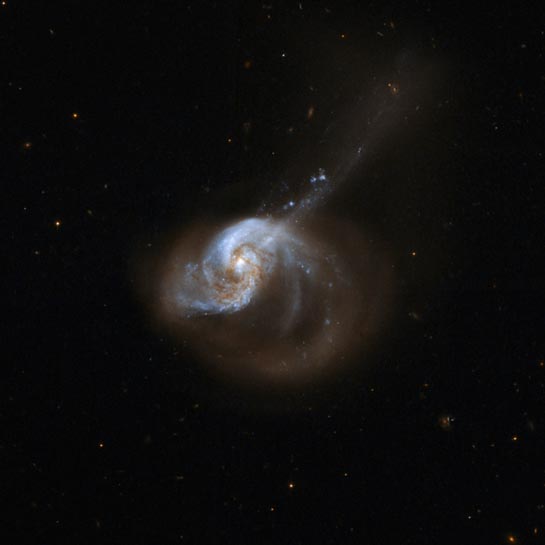
Interacting Galaxies
RA 04h 33m 59.98s Dec -8° 34' 42.8"
Eridanus
200 million light-years (50 million parsecs)
12.9
1.3 by 0.9 arcmin
August 13, 2002
33 minutes
F435W (B) and F814W (I)
NASA, ESA, the Hubble Heritage (STScI/AURA)-ESA/Hubble Collaboration, and A. Evans (U of Virginia, Charlottesville/NRAO/Stony Brook University)
April 24, 2008
ABOUT THIS IMAGE:
NGC 1614, captured here by the NASA/ESA Hubble Space Telescope, is an eccentrically-shaped galaxy ablaze with activity. The galaxy resides about 200 million light-years from Earth and is nestled in the southern constellation of Eridanus (The River). It was discovered on December 29, 1885 by American astronomer Lewis Swift.
NGC 1614 is the result of a past galactic merger which created its peculiar appearance. The cosmic collision also drove a turbulent flow of interstellar gas from the smaller of the two galaxies involved into the nucleus of the larger one, resulting in a burst of star formation which started in the core and slowly spread outwards through the galaxy.
Owing
to its turbulent past and its current appearance, astronomers classify
NGC 1614 as a peculiar galaxy, a starburst galaxy, and a luminous infrared
galaxy. Luminous infrared galaxies are among the most luminous objects
in the local Universe - and NGC 1614 is, in fact, the second most luminous
galaxy within 250 million light-years.
This image is part of a large collection of 59 images of merging galaxies taken by the Hubble Space Telescope and released on the occasion of its 18th anniversary on 24th April 2008.
From Wikipedia:
NGC 1614 is the New General Catalogue identifier for a spiral galaxy in the equatorial constellation of Eridanus. It was discovered on December 29, 1885 by American astronomer Lewis Swift, who described it in a shorthand notation as: pretty faint, small, round, a little brighter middle. The nebula was then catalogued by Danish-Irish astronomer J. L. E. Drayer in 1888. When direct photography became available, it was noted that this galaxy displayed some conspicuous peculiarities. American astronomer Halton Arp included it in his 1966 Atlas of Peculiar Galaxies. In 1971, Swiss astronomer Fritz Zwicky described it as a "blue post-eruptive galaxy, compact patchy core, spiral plumes, long blue jet SSW".
In the De Vaucouleurs system for classifying galaxies, NGC 1614 has a galaxy morphological classification of SB(s)c pec. The SB indicates this is a barred spiral galaxy, while the '(s)' means it lacks a ring-like structure around the nucleus. The trailing 'c' describes the spiral arm structure as being loosely wound. The peculiar nature of the galaxy is noted with the 'pec.' abbreviation. The galaxy is bright at the center, with two nearly symmetrical inner spiral arms.It is a luminous infrared source, with a total infrared luminosity of 1011.60 L☉, ranking 55th in the 2003 IRAS Revised Bright Galaxy Sample, and is the second most luminous galaxy within 75 Mpc.
This galaxy is undergoing a minor merger event with a gas-rich, low-mass companion galaxy, located in a tidal tail to the southwest of the nucleus. The main galaxy is estimated to be around 3-5 times as massive as the merging object. The interaction between the two galaxies is triggering a burst of star formation in NGC 1614, although not apparently an active galactic nucleus. It is described as "one of the most extreme nearby starbursts".
In
the core region, a 230 pc radius ring feature has formed around the nucleus
within the last 5-10 million years from an inflow of gas caused by the
merger event, and this structure is the site of the intense star forming
activity known as a starburst region. This activity is bright enough that
it is masking whatever weak nuclear emission there is coming from the
core. The nucleus itself displays evidence of an older starburst event.
The starburst activity is presumed to be driving an observed outflow of
cold molecular gas that has a combined mass of around 32 million times
the mass of the Sun.